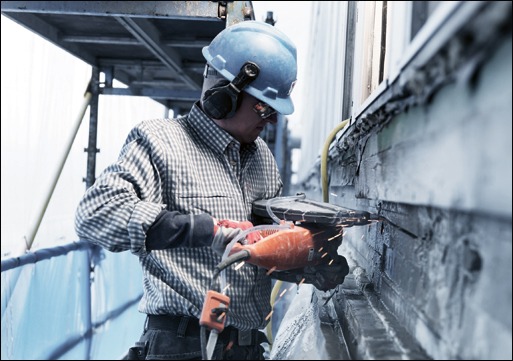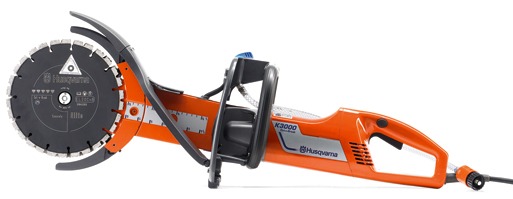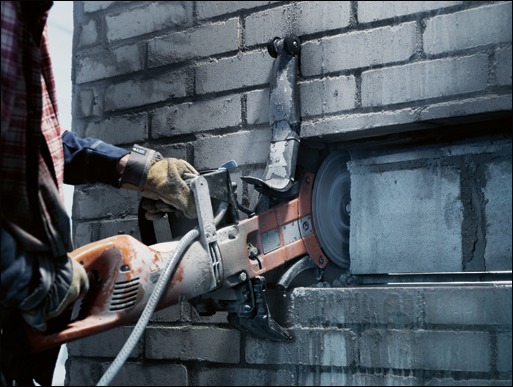Saws
How Safe is Your Power Cutter?
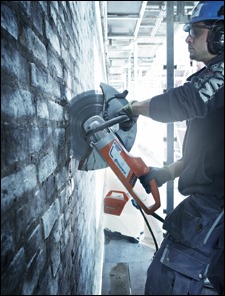 |
|
| Husqvarna K3000 Wet Power Cutter |
When a contractor has a project that includes cutting indoors, planning is a crucial step. Each job carries a unique set of circumstances that need to be considered if the job is to be a success. In all jobs – especially when cutting indoors – safety, choosing the right equipment and planning are the keys to proper preparation and, ultimately, a job well done.
Knowing all the requirements and specifications of the job is central to completing the project successfully. Cutting indoors means considering the safety of the operators and residents as well as the equipment to be used. Since indoor work generally means disrupting a place of business, school or home, contractors have to be sensitive about the time of day the work takes place and how quickly it can be accomplished.
To assure a job stays on schedule or ahead of schedule, it is important to plan and identify all hazards. This will reduce the chance of accidents, delays, unexpected costs and losses of profit. Most indoor jobs call for cutting window or door openings in walls, but also can include cutting bricks and blocks when remodeling a basement, adding spaces for HVAC units or duct work according to specifications. Some of the time these types of projects will require the use of a hand-held power cutter.
| Product Watch |
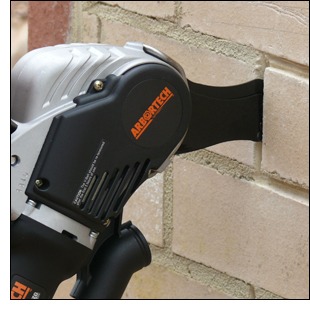 Arbortech’s new Head Joint and Heritage blades offer controlled cuts and precision for mortar removal on vertical joints and narrow mortar joints. The blades are available as aftermarket accessories for the Arbortech AS170 Brick and Mortar saw. Arbortech’s new Head Joint and Heritage blades offer controlled cuts and precision for mortar removal on vertical joints and narrow mortar joints. The blades are available as aftermarket accessories for the Arbortech AS170 Brick and Mortar saw.
The Head Joint blades are ideal for cleaning out vertical mortar joints, with the ability to clean out the complete joint without any damage to surrounding bricks. A shortened blade offers precision and is easy to control, even when the user starts cuts in hard mortar. The cutting depth is 3 1/8-inch deep, and the cutting width is 1/4-inch wide. Developed in response to feedback from heritage restoration specialists, the Heritage blades have a reduced cutting width of 1/8-inch and a high level of precision and control, allowing them to clean out the narrow lime mortar joints typically found in historic buildings. Both blades feature a high-performance carbide formula and tooth design, and high-temperature brazing. The AS170’s patented Allsaw cutting technology uses an orbital cutting motion with two forward-facing blades that combine to perform both a hammering and a cutting action. This allows the users to have clear visibility and the ability to accurately cut squarely and deeply. For more information, visit www.AS170.com. |
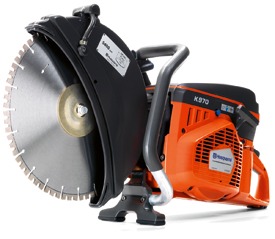 |
|
| K970 Gas Powered Power Cutter |
Areas to consider
Typical areas to consider when working in indoor, potentially confined spaces include:
Air/ventilation
- Knowing if there is proper ventilation or air flow in the work space will help determine if a gas or electric power cutter is better to use on the project
- Gas engines produce carbon monoxide and can be fatal if exposed to in an area not properly vented.
Type of material to be cut
- Knowing how thick the material is will help determine which tool is best to use. If a project calls for making deep cuts, such as in walls, a chain saw or Cut-n-Break would be better to use than a typical power cutter
- The type of material also will establish what type of blade to use. If the proper blade is not used for the material to be cut, safety hazards increase, and the power cutter potentially can perform poorly and lose productivity.
Dust and debris
- If the indoor area is not properly ventilated, dust can accumulate in the space and can be hazardous to the operator
- Dust and debris can make it difficult to see if it accumulates in the area for a long period. It also is dangerous to the operator’s health if inhaled for an extended amount of time.
If the area to be cut has poor air flow and dust/debris needs to be controlled, the best tool to use would be an electric power cutter, due to the fact that it is lightweight and can be used either wet or dry. However, how safe is it to use an electric power cutter, especially if the contractor is going to cut wet?
It is important to choose a power cutter that has been designed and approved for wet cutting. An electric power cutter specifically designed to cut wet will have a GFCI or Ground-Fault Circuit Interrupter installed to help protect the user if there is damage to the electric circuit. Saws intended to cut with water are designed in a way to protect the electrical components from water that would otherwise interfere with safe operation of the power cutter. Power cutters that are intended to cut with water have special features that keep the electrical components away from the water used to help make the cuts and, therefore, prevent potential accidents. Keep in mind, when selecting a power cutter designed for wet cutting, that wet cutting power cutters can be used for dry cutting, but a dry cutting power cutter cannot be used to cut wet.
| Product Watch |
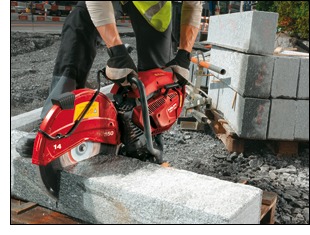 Designed from the ground, up, to incorporate features and requirements that professionals have asked for, the new Hilti DSH 700 and DSH 900 hand-held gas saws give operators more productivity with less downtime. These new Hilti gas saws perform well in a variety of construction materials, including cutting wet/dry concrete and asphalt for small repair projects, expansion joints and curbs, and brick and concrete block for small floor or wall openings. These Hilti hand-held gas saws also cut metal deck, rebar, bolts dowel bars, grating and other metals. Designed from the ground, up, to incorporate features and requirements that professionals have asked for, the new Hilti DSH 700 and DSH 900 hand-held gas saws give operators more productivity with less downtime. These new Hilti gas saws perform well in a variety of construction materials, including cutting wet/dry concrete and asphalt for small repair projects, expansion joints and curbs, and brick and concrete block for small floor or wall openings. These Hilti hand-held gas saws also cut metal deck, rebar, bolts dowel bars, grating and other metals.
For more information, visit www.us.hilti.com. |
When wet cutting, it is important to monitor the amount of water used as it is a big factor regarding clean-up time. Too much water will need to be mopped, shoveled, dried, swept and vacuumed to be removed. On the other hand, if a power cutter that has reduced water flow is used, the dust/debris will be in the form of a paste-like slurry that can be easily swept or scooped up. It is essential to use the appropriate blade for the material to be cut as well, since this will reduce the amount of slurry to clean up. The amount of dust and debris generated by how fast the cut is made will reduce the amount of time it takes to clean up. The longer a blade rotates to grind away the material while making the cut, the more the air is disturbed, and the longer the dust and debris travels through the air and, ultimately, settles farther away from the cut.
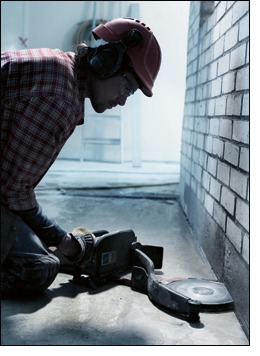 |
|
| K3000 CnB flush cut |
The same concept can be applied to water. The more water used, the more slurry created and a larger area to clean forms. If a contractor doesn’t initially plan for a way to contain the debris, it will take away time from the actual job at hand. For these reasons, it is important to choose the right blade for the material and application. Information about the recommended application: dry cutting, wet cutting or dry/wet cutting, along with the material it cuts, should be specified on the blade by the manufacturer. Since blade quality and price go hand-in-hand, choosing the appropriate blade in the planning stages will save money and time in the long run.
| Product Watch |
 Stone Construction Equipment Inc.’s Stone Saw Devil MS1 and MS2 line consists of a lightweight, portable block saw and an extra rugged, heavy-duty professional block saw. The two models are offered with a variety of engine and blade guard options. The saws’ all steel frames, sealed bearings and stationary engine platforms stand up to the most complicated block cutting and include features like cast aluminum cutting carts with nylon wheels and non-slip rubber tops; open-back design allows rip cutting the entire length of larger blocks; and stay-level blade guards with full blade clamp coverage to keep blade parallel to the cutting surface. Stone Construction Equipment Inc.’s Stone Saw Devil MS1 and MS2 line consists of a lightweight, portable block saw and an extra rugged, heavy-duty professional block saw. The two models are offered with a variety of engine and blade guard options. The saws’ all steel frames, sealed bearings and stationary engine platforms stand up to the most complicated block cutting and include features like cast aluminum cutting carts with nylon wheels and non-slip rubber tops; open-back design allows rip cutting the entire length of larger blocks; and stay-level blade guards with full blade clamp coverage to keep blade parallel to the cutting surface.
For more information, visit www.stone-equip.com. |
Coupled with the correct blade selection, an electric power cutter is an efficient choice for almost all indoor cutting jobs. Electric power cutters can cut anything that a gas power cutter can; but, unlike gas power cutters, electric versions can be used both indoors and outdoors making them a versatile machine. Electric power cutters also produce less noise, which is necessary if cutting in an outdoor or indoor area, where noise needs to be minimized.
Once all requirements and safety issues have been solved, it is time to finish, review and execute the plan to a successful job. The indoor factor when cutting adds a new element that needs to be addressed. However, when the areas of concern are considered in the planning stages of the project and the right tools have been selected, the job will be completed with ease.

